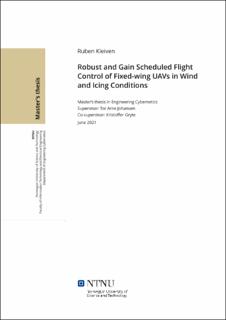| dc.contributor.advisor | Johansen, Tor Arne | |
| dc.contributor.advisor | Gryte, Kristoffer | |
| dc.contributor.author | Kleiven, Ruben | |
| dc.date.accessioned | 2021-09-23T18:54:30Z | |
| dc.date.available | 2021-09-23T18:54:30Z | |
| dc.date.issued | 2021 | |
| dc.identifier | no.ntnu:inspera:76427839:26411894 | |
| dc.identifier.uri | https://hdl.handle.net/11250/2781074 | |
| dc.description.abstract | Inspirert av de stadig voksende bruksområdene for droner, fokuserer denne oppgaven på robust og "gain scheduled" regulering av fastvingedroner i vind- og isforhold. Hovedmålet for dette arbeidet er å generere et sett med regulatorer som løser vanskeligheter knyttet til modellusikkerhet, atmosfærisk ising og vindforstyrrelser. Flere mellomtrinn utført i denne prosessen. En programvarepakke i Python er utviklet for å utføre systemanalyse, regulator tuning og numeriske simuleringer. En grundig egenverdianalyse er utført for å sammenligne de isdannede endringene i det dynamiske systemet med den ordinære dronen uten is. I tillegg er en asymmetrisk flymodell utledet fra symmetriske data for å utføre virkelighetsreelle simuleringer relatert til avisning. Til slutt er regulatorene utviklet og testet i simulatoren.
Regulatormetodene er basert på $\mathcal{H}_\infty$ regulering, og bruker en systematisk tune-prosedyre for tuning. Regulatorene ble testet gjennom numeriske simuleringer ved hjelp av den nevnte programvaren. Fra denne simuleringen kan det konkluderes med at både den enkle robuste regulatoren og "gain scheduled" regulatoren gir tilfredsstillende resultater når det gjelder stabilitet, robusthet og ytelse. Ved å sammenligne resultatene fra ytelsestestene for de to regulatorene, gir regulatorytelsen til "gain scheduled" regulatoren de beste resultatene. Dette viser at man kan forbedre regulatorens ytelse mens man følger definerte lukket sløyfe robusthets- og stabilitetskrav ved å inkludere kunnskap om isingsnivået.
En avisingsprosess er simulert for den enkle robuste regulatoren ved forskjellige vindhastigheter. Her er tendensen klar; høyere vindhastighet minimerer forstyrrelsene relatert til momentan avising. | |
| dc.description.abstract | Inspired by the growing field of application of unmanned aerial vehicles (UAVs), this thesis investigates robust and gain scheduled flight control of fixed-wing UAVs in wind and icing conditions. The motivation for this work is to generate a set of controllers that overcomes the difficulties related to plant uncertainties, atmospheric in-flight icing and wind disturbances.
The main objective is to develop controllers that mitigate the aerodynamic effects of wind and icing on the UAV. However, several intermediate steps are completed to create and test these controllers. Specifically, a simulation software package in Python is developed to perform system analysis, controller tuning and numerical simulations. A thorough dynamic mode analysis is made to compare the icing-induced changes of the dynamic system to the basic clean UAV. An asymmetric aircraft model is deduced from symmetrical data to perform lifelike simulations related to de-icing. At last, the controller is implemented using a systematic loop-shaping procedure and tested in the simulation environment.
The controller methods are based on $\mathcal{H}_\infty$ control approach and using a systematic loop-shaping design procedure for tuning. The control methods were tested through numerical simulations using the developed software package. From these simulations, it is concluded that both the single robust controller and the gain scheduled controller gives satisfactory results in terms of stability, robustness and performance. However, by comparing the results from the performance test runs for the two controllers, the control performance of the gain-scheduled control approach gives better results. This result proves that one can improve the controller performance while fulfilling the closed-loop robustness and stability requirements by including knowledge of icing.
In-flight de-icing is performed using the single robust controller for different levels of airspeed. The tendency is clear; higher airspeed within the tested range of reasonable UAV airspeeds reduces the disturbance related to instantaneous removal of ice. | |
| dc.language | eng | |
| dc.publisher | NTNU | |
| dc.title | Robust and Gain Scheduled Flight Control of Fixed-wing UAVs in Wind and Icing Conditions | |
| dc.type | Master thesis | |
